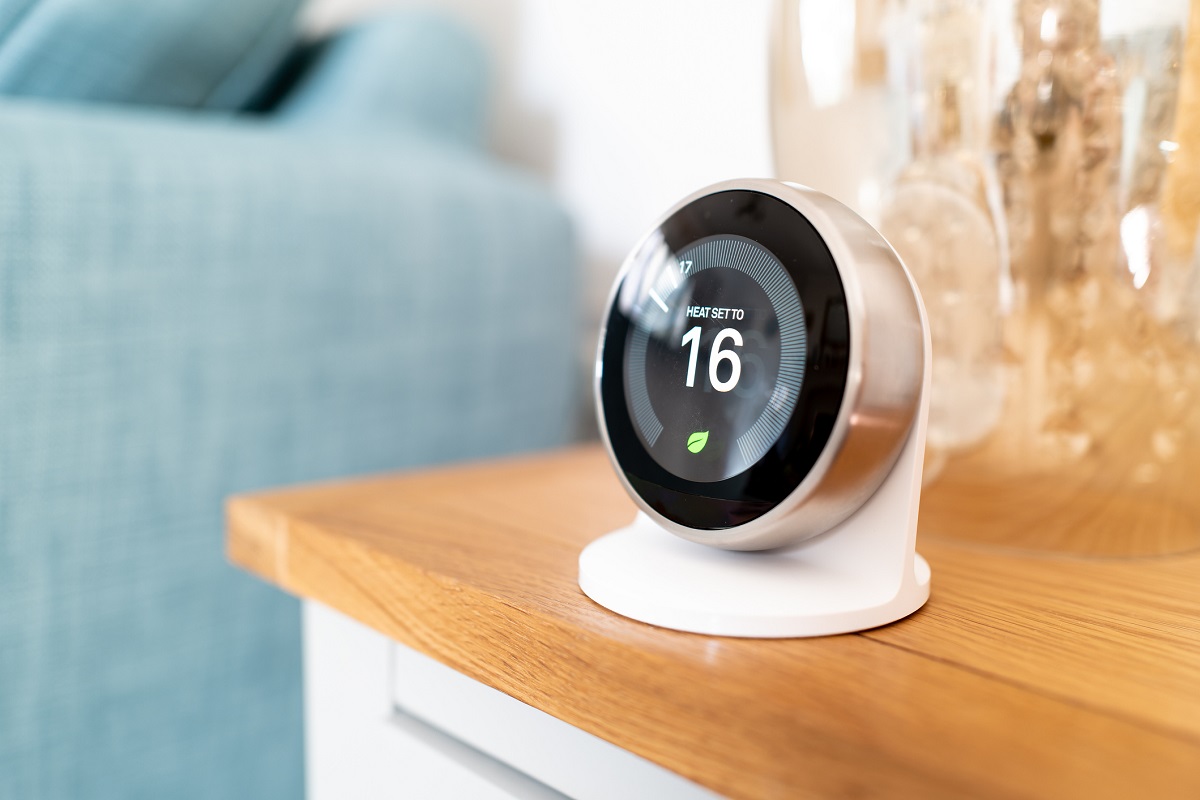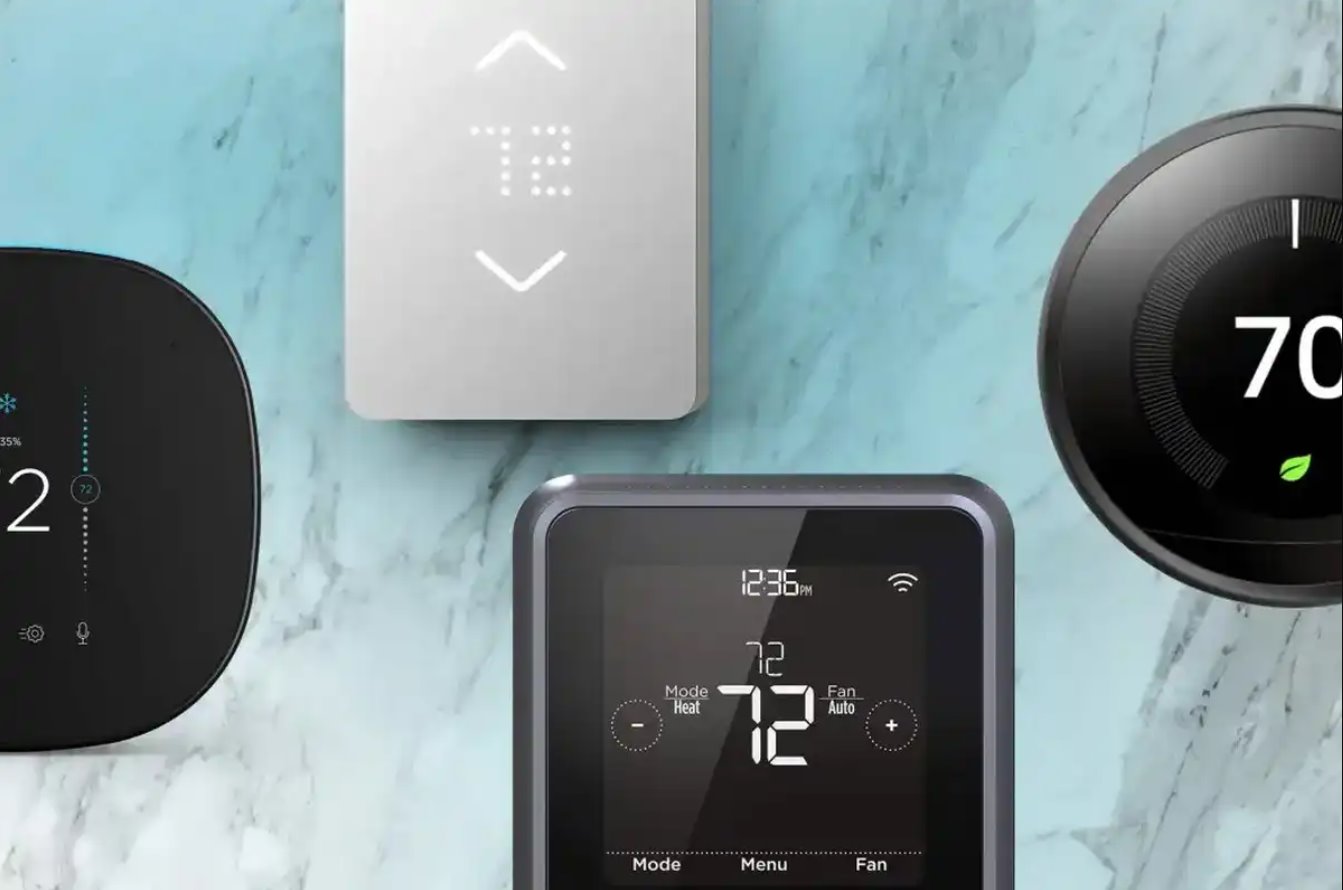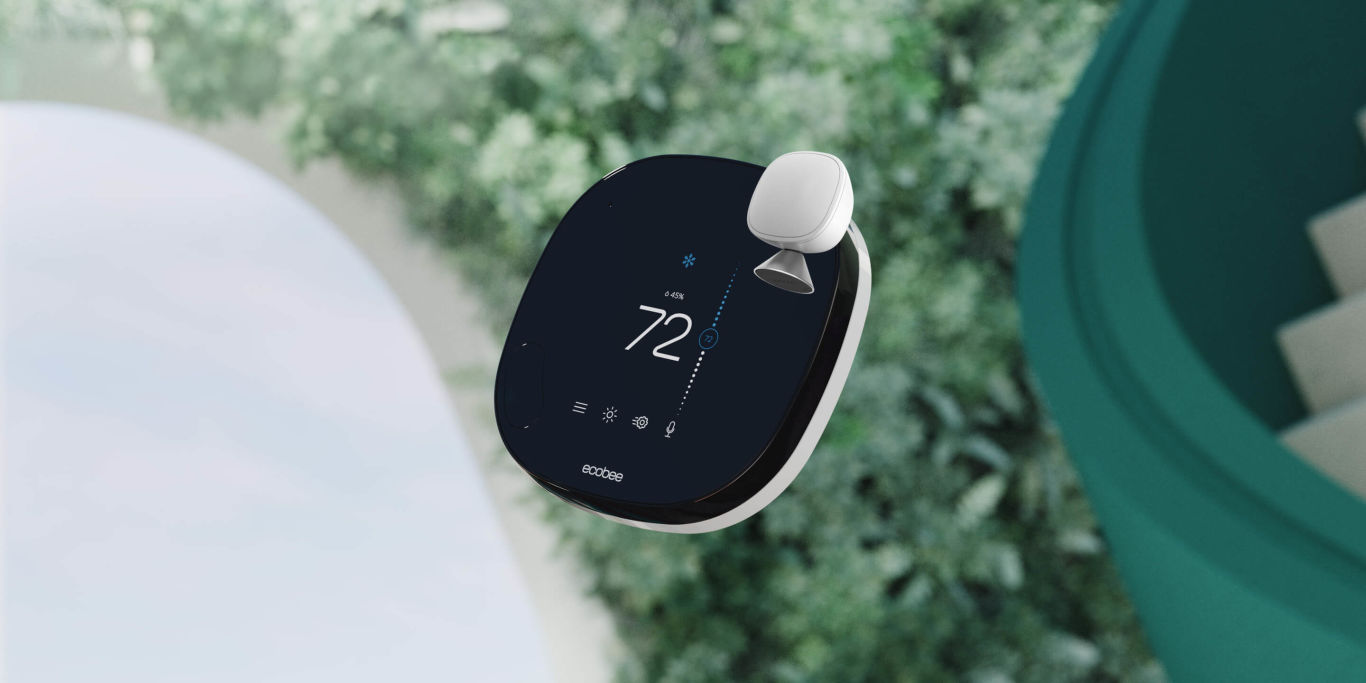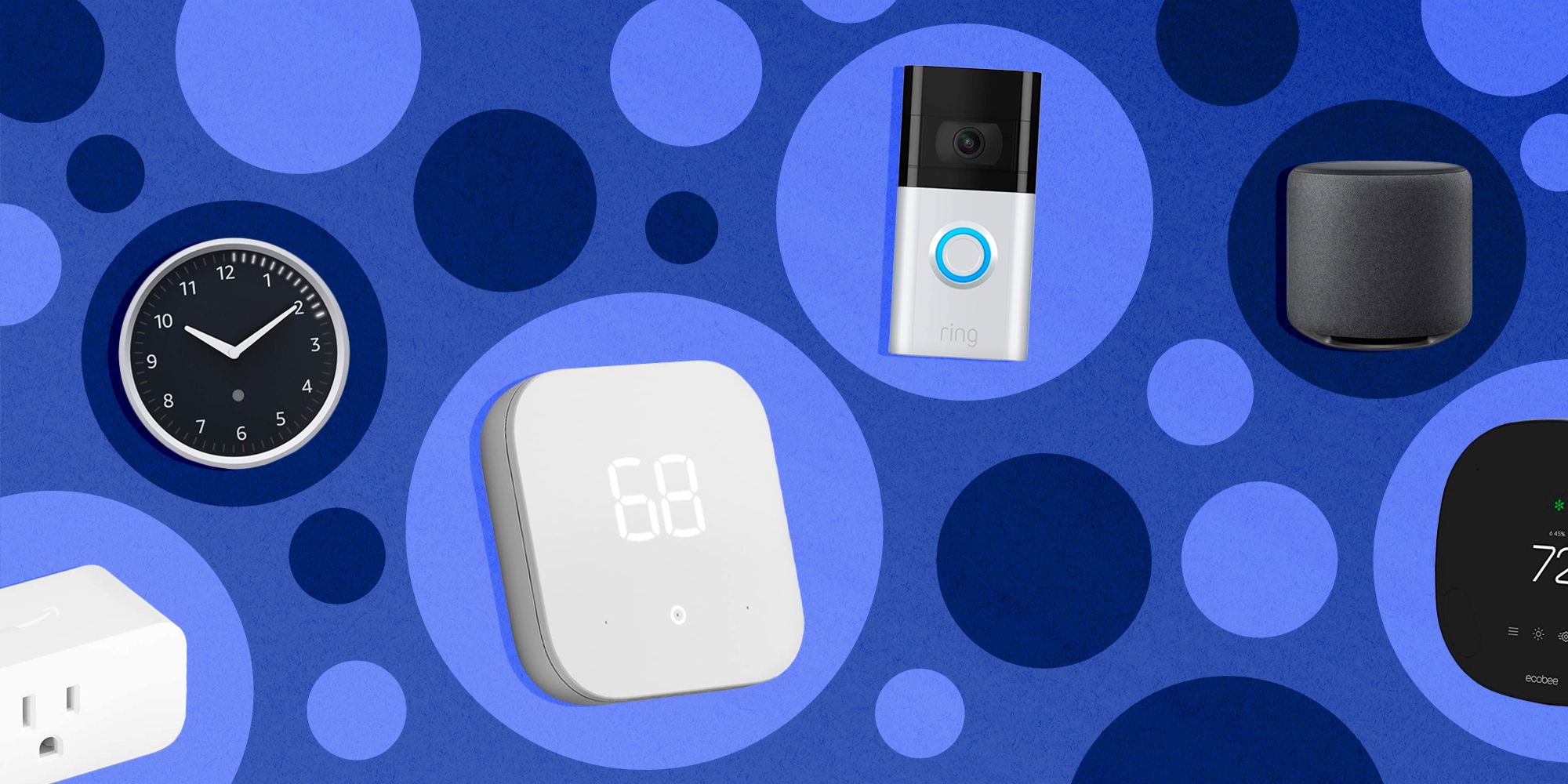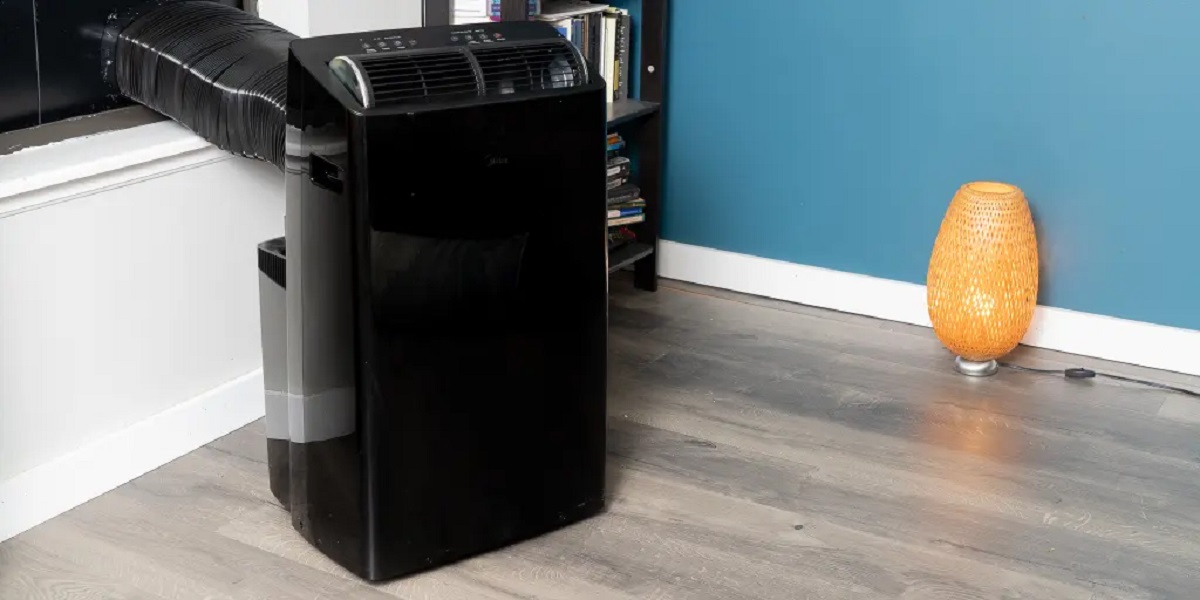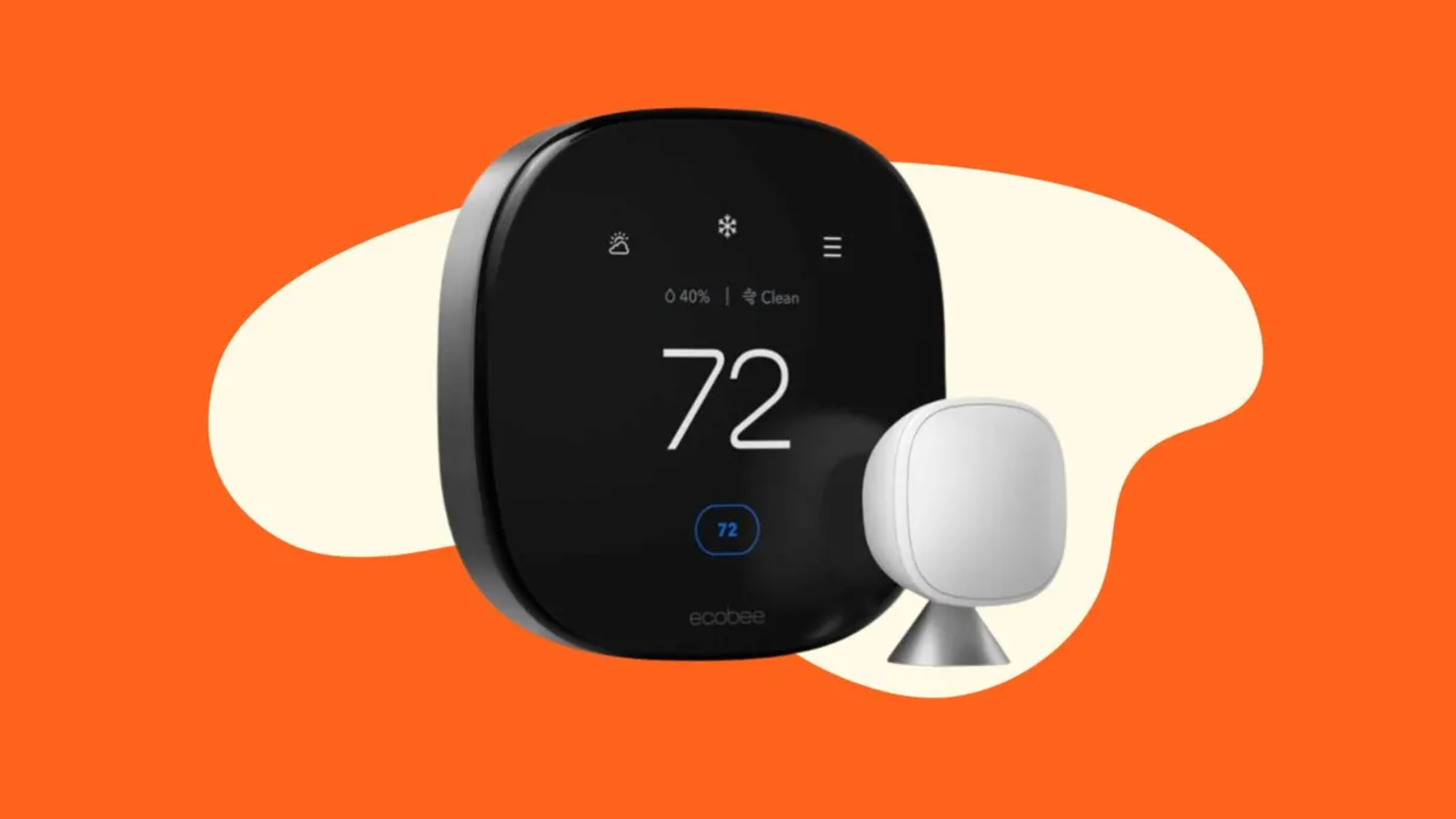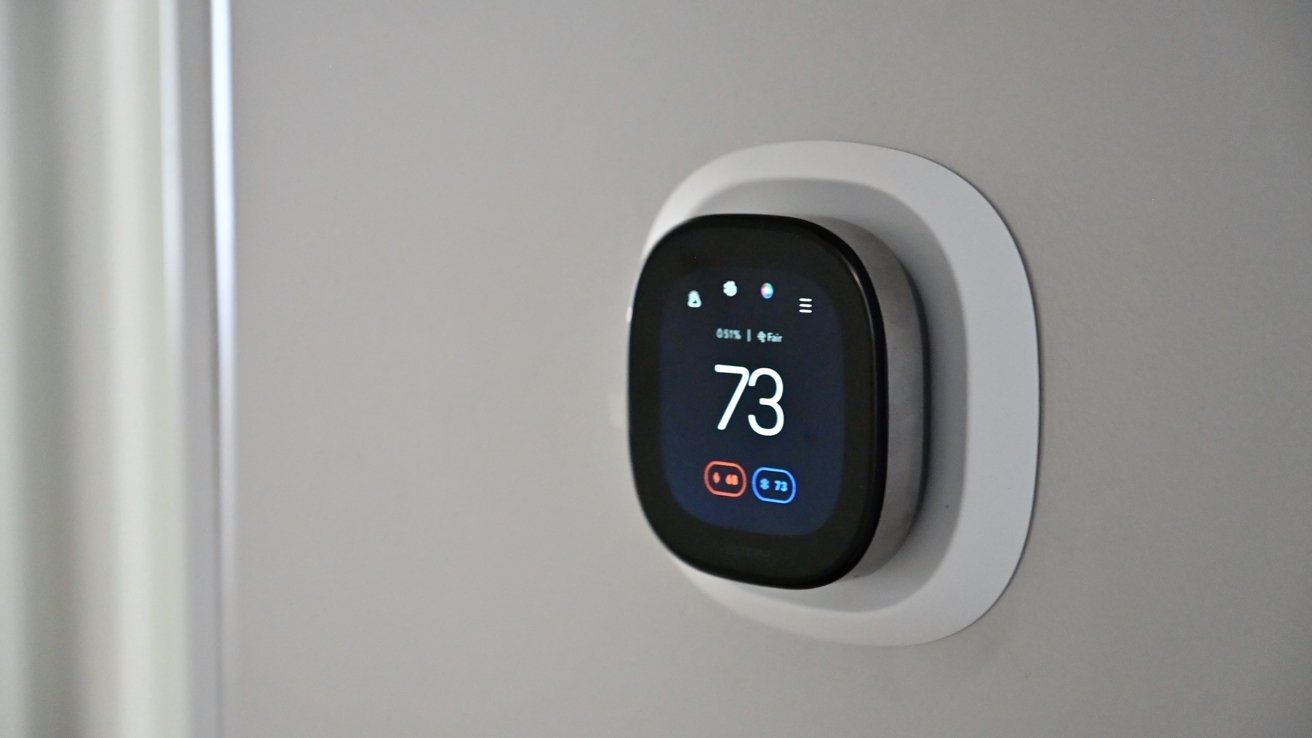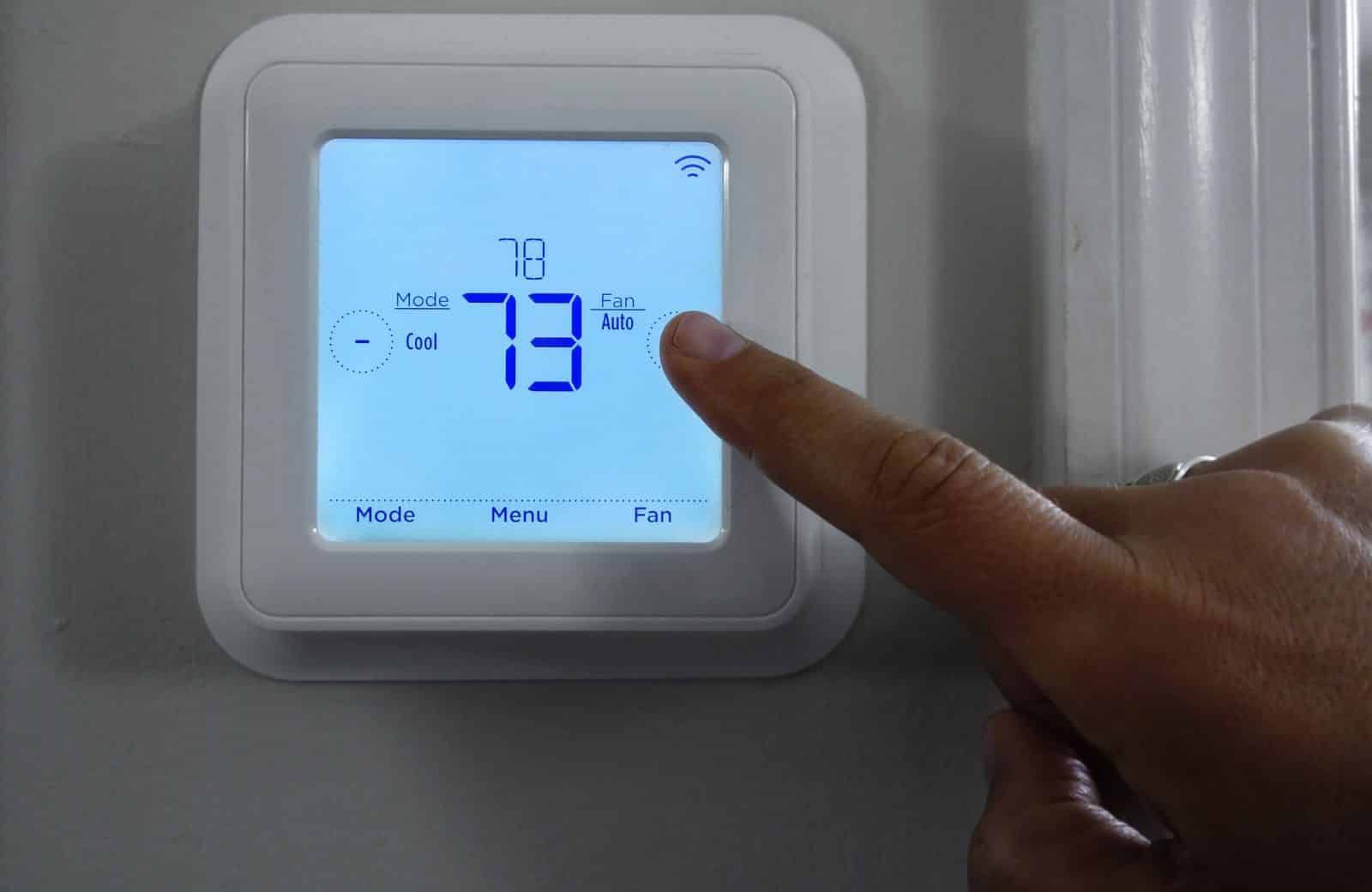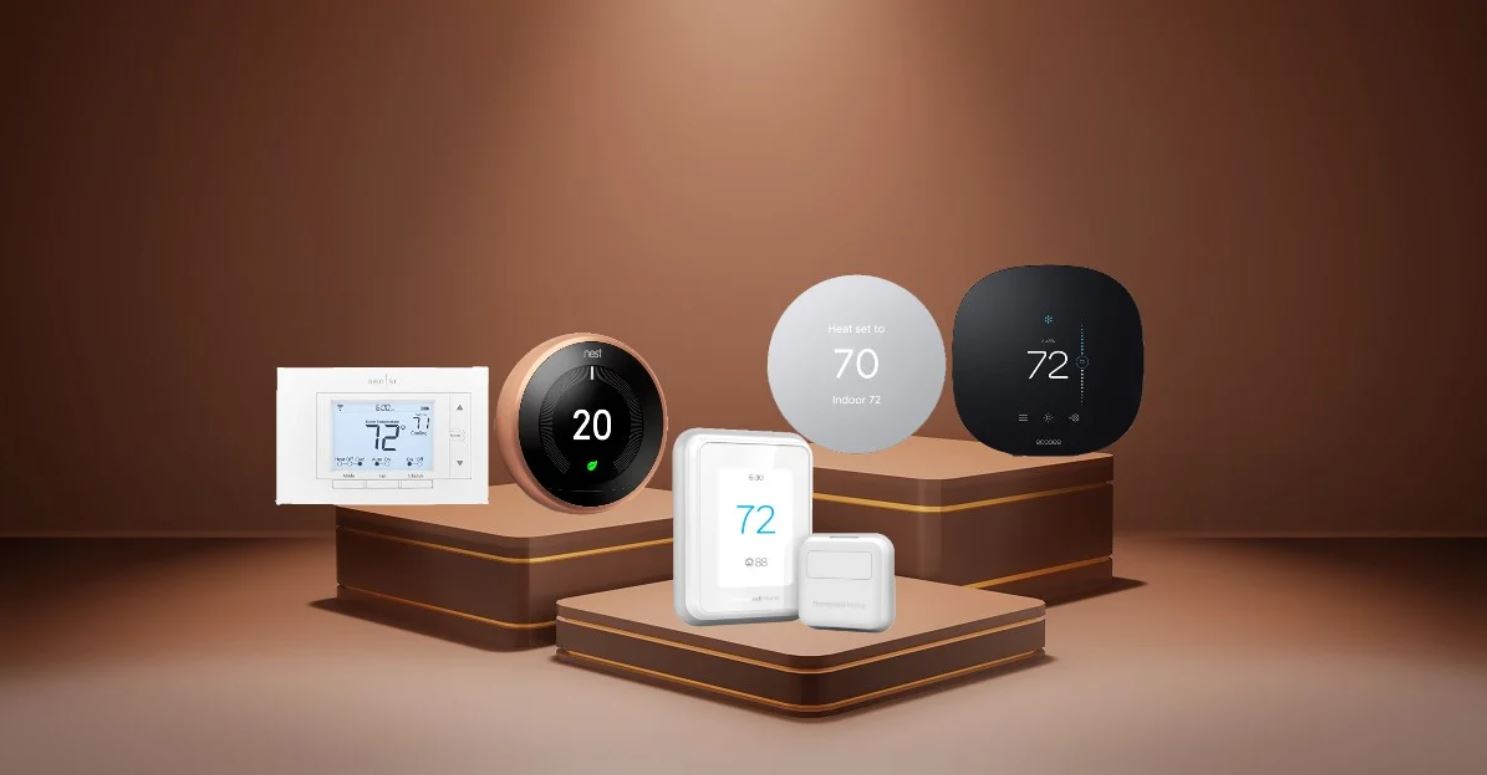Introduction
Welcome to the world of smart thermostats! In today’s digitally-driven society, technological advancements continue to revolutionize our everyday lives, including the way we control the temperature of our homes. Gone are the days of manually adjusting your thermostat several times a day. Now, with the advent of smart thermostats, you can conveniently and intelligently manage the climate of your living space with just a few taps on your smartphone or the sound of your voice.
A smart thermostat is a device that combines the functionality of a traditional thermostat with the power of modern technology. It not only allows you to control your home’s heating, ventilation, and air conditioning (HVAC) system remotely but also employs advanced algorithms and sensor technology to optimize energy usage and enhance home comfort.
By utilizing an array of sensors, connectivity features, and learning algorithms, a smart thermostat continuously adapts to your schedule, preferences, and external factors to provide the ideal temperature conditions while minimizing energy waste. With these devices, you can save money on utility bills, reduce your carbon footprint, and enjoy a more comfortable home environment.
In this article, we will take a closer look at the key components of smart thermostats, explore how they work, and delve into the multitude of benefits they offer. So, let’s jump in and discover the inner workings of these ingenious devices that are transforming the way we control our home’s climate!
What is a Smart Thermostat?
A smart thermostat is an advanced device designed to regulate and control the temperature of your home’s HVAC system. Unlike conventional thermostats that require manual adjustment, smart thermostats can be programmed, monitored, and controlled remotely, often through a smartphone app or voice commands via a smart home assistant.
What sets smart thermostats apart is their ability to learn from your behavior and adjust your home’s climate settings accordingly. Using built-in sensors, these devices can detect occupancy, ambient temperature, humidity levels, and other factors to optimize energy usage and create a comfortable living space.
Smart thermostats offer a host of features and functionalities that make them a valuable addition to any home. These devices are designed with user-friendly interfaces, intuitive controls, and interactive displays that provide real-time information about your energy consumption and system performance.
One of the primary benefits of a smart thermostat is its energy efficiency capabilities. By employing learning algorithms and advanced scheduling features, these devices can automatically adjust temperature settings based on your habits, occupancy patterns, and external weather conditions. This not only keeps your home comfortable but also reduces unnecessary energy usage, leading to potential cost savings on your utility bills.
In addition to energy conservation, smart thermostats offer increased convenience and control. With remote access, you can monitor and adjust your home’s temperature settings from anywhere, anytime. This means you can pre-heat or cool your home before your arrival or make adjustments on the go using your smartphone or voice commands, providing ultimate flexibility and comfort.
Another noteworthy aspect of smart thermostats is their compatibility with other smart home devices. These devices often integrate with voice assistants, such as Amazon Alexa or Google Assistant, allowing you to control your thermostat using simple voice commands. They can also be paired with other smart home devices like smart lighting, security systems, and blinds, creating a synchronized and automated home environment.
Overall, a smart thermostat offers a myriad of benefits, including energy savings, convenience, and enhanced comfort. Its intelligent features and connectivity options make it a valuable tool for modern homeowners seeking a more efficient and automated way to manage their home’s climate.
Benefits of a Smart Thermostat
Investing in a smart thermostat brings a range of benefits that go beyond simply controlling the temperature of your home. These innovative devices offer a host of advantages that enhance comfort, improve energy efficiency, and provide greater convenience in managing your home’s climate. Let’s explore some of the key benefits of using a smart thermostat:
Energy Savings: Smart thermostats are designed to optimize energy usage by automatically adjusting temperature settings based on your preferences, occupancy patterns, and external factors. through learning algorithms and sensor technology, they can create a personalized heating and cooling schedule that minimizes wasted energy, leading to potential cost savings on your utility bills.
Convenience and Control: With remote access capabilities, smart thermostats allow you to control your home’s temperature settings from anywhere, anytime. Whether you’re at work, on vacation, or simply in a different room, you can easily adjust the thermostat using your smartphone or even with voice commands via a smart home assistant.
Enhanced Comfort: Smart thermostats provide precise control over your home’s climate, ensuring optimal comfort for you and your family. By monitoring factors like humidity, temperature, and occupancy, these devices can make automatic adjustments to maintain the desired temperature and humidity levels, creating a more comfortable living environment.
Learning Capabilities: Smart thermostats use advanced machine learning algorithms to analyze your behavior, preferences, and external conditions. Over time, they learn your schedule, temperature preferences, and even adapt to changing weather conditions. This means you don’t have to constantly adjust the thermostat manually – it will do it for you based on your patterns and preferences.
Integration with Smart Home Devices: These thermostats can seamlessly integrate with other smart home devices, allowing you to create a fully synchronized and automated living space. For example, you can link your thermostat to smart lights or blinds, so they adjust automatically based on your temperature preferences or occupancy, creating a seamless and energy-efficient home environment.
Energy Usage Insights: Smart thermostats provide valuable insights into your energy consumption. With interactive displays and real-time data, you can monitor how your HVAC system is performing, track energy usage trends, and identify opportunities for further energy savings. This empowers you to make informed decisions about your energy consumption and take steps towards a more sustainable and eco-friendly lifestyle.
Overall, the benefits of a smart thermostat extend beyond convenience and control. These devices offer energy savings, enhanced comfort, and valuable insights into energy consumption, making them an excellent addition to any modern home.
Components of a Smart Thermostat
A smart thermostat is a sophisticated device that comprises several key components working together to deliver efficient temperature control and advanced features. Understanding the components of a smart thermostat can provide valuable insight into how these devices function. Here are the essential components found in a typical smart thermostat:
Temperature Sensor: A temperature sensor measures the ambient temperature in the room or space where the thermostat is installed. This sensor is crucial for accurately detecting changes in temperature and informing the thermostat’s control algorithms.
Humidity Sensor: Some smart thermostats include a humidity sensor that measures the level of moisture in the air. This information assists in maintaining ideal humidity levels, maximizing comfort, and preventing issues like mold growth in the home.
Occupancy Sensor: An occupancy sensor detects human presence in the room or space. This sensor helps determine whether the area is occupied, allowing the thermostat to adjust temperature settings accordingly. When the room is empty, the thermostat can automatically adjust the temperature to save energy.
Display: The display on a smart thermostat provides essential information like current temperature, target temperature, and system status. It allows users to view and manually adjust settings directly on the device, making it easy to control the thermostat without relying solely on smartphone apps or voice commands.
Connectivity Features: Smart thermostats typically include various connectivity options to enable remote access and control. These features might include Wi-Fi or Bluetooth connectivity, allowing you to connect the thermostat to your smartphone, tablet, or other devices. This remote connectivity enables you to monitor and adjust temperature settings even when you’re away from home.
Processor and Memory: The processor and memory of a smart thermostat handle the computing tasks and storage of data. These components are responsible for running the complex algorithms needed for learning and adapting to user behaviors, as well as storing temperature schedules, user preferences, and other settings.
User Interface: The user interface on a smart thermostat allows users to interact with the device and adjust settings. This interface can take the form of buttons, touchscreens, or a combination of both. A user-friendly interface is crucial for easy navigation and intuitive control of the thermostat’s features and settings.
Power Source: Smart thermostats generally require a power source to function. They can be either hardwired into the home’s electrical system or powered by replaceable batteries. Some models combine both options, using the electrical connection as the primary power source and batteries as a backup.
Compatibility with HVAC Systems: Lastly, smart thermostats are designed to be compatible with various heating, ventilation, and air conditioning (HVAC) systems. They can work with single-stage or multi-stage heating and cooling systems, as well as heat pumps and other HVAC configurations. Ensuring compatibility with your specific HVAC system is essential when choosing a smart thermostat.
These components work in synergy to provide precise temperature control, energy optimization, and convenient features in a smart thermostat. Understanding how each element contributes to the overall functionality of the device can help you make an informed decision when selecting the right smart thermostat for your home.
How Does a Smart Thermostat Work?
Smart thermostats operate using a combination of advanced technology, sensors, connectivity, and intelligent algorithms to provide precise temperature control and energy optimization. Let’s take a closer look at how these devices work:
Firstly, smart thermostats collect data from various sensors. These sensors include temperature sensors, humidity sensors, and occupancy sensors. The temperature sensors detect the current ambient temperature, while the humidity sensors measure the moisture levels in the air. The occupancy sensors detect human presence in the room or space. By gathering information from these sensors, the smart thermostat can gather the necessary data to make informed decisions regarding temperature control.
The collected data is then processed by the thermostat’s built-in processor and analyzed using complex algorithms. These algorithms take into account factors such as ambient temperature, desired temperature settings, occupancy patterns, and external weather conditions. By analyzing this data, the smart thermostat can determine the optimal temperature settings for efficient energy usage and comfort.
Many smart thermostats also employ machine learning algorithms that adapt to the user’s behavior and preferences over time. As the user manually adjusts temperature settings or as the thermostat senses changes in occupancy, the algorithms learn patterns and make proactive adjustments to automatically adjust the temperature in a way that suits the user’s preferences and lifestyle.
Connectivity is another crucial aspect of smart thermostats. Most smart thermostats feature Wi-Fi or Bluetooth connectivity, allowing users to control the thermostat remotely using a smartphone app or voice commands via a smart home assistant. This remote access enables users to adjust temperature settings, create custom schedules, and monitor energy usage even when they are not physically present in the home.
Smart thermostats often have energy-saving features to optimize energy usage. These features may include geofencing, which uses the location of the user’s smartphone to determine when they are leaving or approaching home, allowing the thermostat to adjust settings accordingly. Some smart thermostats can also integrate with weather data, dynamically adjusting temperature settings based on external conditions to maximize energy efficiency.
Additionally, smart thermostats can integrate with other smart home devices. They can communicate with smart lighting systems, motorized blinds, and other devices to create a synchronized and automated home environment. For example, when the thermostat detects that the occupants have left the house, it can signal the lights to turn off and adjust settings to an energy-saving mode.
Overall, a smart thermostat leverages advanced technology, sensors, connectivity, and intelligent algorithms to create an energy-efficient and comfortable home environment. By continuously adapting to user behavior, external conditions, and occupancy patterns, these devices ensure optimal temperature control while reducing energy waste.
The Role of Sensors
Sensors play a crucial role in the functionality of a smart thermostat, providing the device with the necessary data to accurately regulate and control the temperature of a home. These sensors are instrumental in gathering information about the ambient temperature, humidity levels, and occupancy patterns, allowing the thermostat to make informed decisions regarding temperature adjustments and energy optimization. Let’s explore the role of sensors in a smart thermostat:
Temperature Sensors: Temperature sensors are one of the primary components of a smart thermostat. They measure the current ambient temperature in the room or space where the thermostat is installed. This information serves as the foundation for the thermostat’s temperature control algorithms. By monitoring the changes in temperature, the sensors provide real-time data that helps the smart thermostat determine when to turn the HVAC system on or off and when to adjust the temperature settings.
Humidity Sensors: Some smart thermostats also include humidity sensors that measure the moisture levels in the air. Maintaining optimal humidity levels in a home is crucial for comfort and well-being. The humidity sensors provide data that informs the thermostat about the humidity levels, allowing it to make adjustments to ensure the desired humidity range is maintained. This is particularly beneficial in regions with high humidity, as the smart thermostat can activate the HVAC system or adjust temperature settings accordingly to control moisture and prevent issues such as mold growth.
Occupancy Sensors: Occupancy sensors detect the presence or absence of occupants in a room or space. These sensors use infrared technology, motion detection, or other methods to determine if someone is present. By detecting occupancy, the thermostat can make intelligent decisions about when to adjust temperature settings. For example, if the occupancy sensor detects that a room is unoccupied for a specified period, the thermostat may lower the temperature or switch to an energy-saving mode to conserve energy. Occupancy sensors contribute to both comfort and energy efficiency by ensuring that heating or cooling is focused on occupied areas only.
The data collected by these sensors is crucial for the smart thermostat’s algorithms to make accurate decisions regarding temperature control and energy optimization. The sensors constantly provide real-time information, allowing the thermostat to adjust settings based on the current conditions of the environment.
By leveraging the input from temperature sensors, humidity sensors, and occupancy sensors, a smart thermostat can create customized temperature profiles based on user preferences and behavior. As the sensors detect changes in temperature, humidity levels, or occupancy, the thermostat can make proactive adjustments to provide optimal comfort while minimizing energy waste.
Overall, sensors are an integral part of smart thermostats, enabling these devices to gather essential data and make informed decisions regarding temperature control and energy optimization. The accurate and timely information provided by these sensors ensures that the thermostat can create a comfortable and energy-efficient living environment.
Connectivity Options for Smart Thermostats
Connectivity is a key feature of smart thermostats, allowing users to remotely access and control their HVAC systems through various devices. These devices provide convenience, flexibility, and energy-saving capabilities. Let’s explore the different connectivity options available for smart thermostats:
Wi-Fi: Wi-Fi connectivity is a common feature in smart thermostats, enabling seamless communication between the thermostat and other devices, such as smartphones, tablets, and computers. By connecting the thermostat to your home Wi-Fi network, you can access and control the thermostat’s settings from anywhere, as long as you have an internet connection. This allows you to monitor and adjust temperature settings, create custom schedules, and receive alerts and notifications via a dedicated smartphone app or web interface.
Bluetooth: Some smart thermostats offer Bluetooth connectivity as an alternative to or in addition to Wi-Fi. Bluetooth allows for short-range wireless communication between the thermostat and compatible devices within close proximity. While Bluetooth’s range is limited, it offers a secure and reliable connection, making it suitable for controlling the thermostat from nearby devices without relying on an internet connection.
Voice Control: Smart thermostats often integrate with popular voice assistants like Amazon Alexa, Google Assistant, or Apple’s Siri. This integration enables users to control their thermostats using voice commands. By simply speaking to the voice assistant, users can adjust temperature settings, set up custom schedules, and even receive real-time updates on temperature conditions. Voice control adds convenience and hands-free operation to smart thermostats, allowing users to manage their HVAC systems effortlessly.
Zigbee or Z-Wave: Zigbee and Z-Wave are wireless communication protocols commonly used in smart home devices. Some smart thermostats incorporate these protocols to connect with other smart devices in your home network, such as smart lights, locks, and security systems. This connectivity allows for seamless integration and coordination between various devices, creating a unified and automated smart home environment.
API Integration: Advanced smart thermostats often provide Application Programming Interface (API) access, allowing developers to create custom applications or integrate the thermostat with third-party systems. API integration opens up possibilities for even more advanced and specific control over your thermostat, enabling you to create custom automation routines or link it with other smart home devices and platforms.
Geofencing: Geofencing is a feature that uses the GPS functionality of your smartphone to determine your location in relation to your home. By setting up a virtual boundary around your home, the smart thermostat can detect when you leave or enter the area. This triggers automatic adjustments to temperature settings based on your proximity, ensuring energy efficiency and comfort as you arrive or leave your home.
These connectivity options provide users with a variety of ways to interact with their smart thermostats, making it convenient to control temperature settings, monitor energy usage, and create personalized schedules to suit their needs. Whether it’s via Wi-Fi, Bluetooth, voice control, or integration with other smart devices, the connectivity options for smart thermostats enhance both comfort and energy efficiency in the modern home.
Learning Algorithms
One of the key features that sets smart thermostats apart from traditional thermostats is their ability to utilize learning algorithms. These algorithms enable the thermostat to adapt and optimize temperature control based on user behavior, preferences, and external factors. Let’s explore how learning algorithms work in smart thermostats:
Smart thermostats employ machine learning algorithms that continuously analyze data collected from sensors, user inputs, and historical patterns. These algorithms process this information to identify patterns, correlations, and trends in temperature preferences, occupancy, and other variables.
The learning algorithms take into account factors such as the time of day, weather conditions, temperature adjustments made by the user, and occupancy patterns. This allows the thermostat to learn and adapt its programming and temperature control strategies accordingly.
Over time, the thermostat’s algorithms become more accurate in predicting the user’s temperature preferences and occupancy patterns. For example, if the user consistently adjusts the temperature at certain times or days of the week, the algorithms will recognize this pattern and automatically make adjustments in the future without the need for manual intervention.
The learning algorithms also consider external factors, such as weather information obtained from online sources or through integration with weather services. By monitoring weather conditions, the thermostat can automatically adjust temperature settings to maintain a comfortable indoor environment while accounting for changes in outdoor temperature and humidity levels.
Occupancy detection is another aspect that learning algorithms take into account. By analyzing occupancy patterns, the thermostat can optimize energy usage based on whether the space is occupied or unoccupied. The algorithms can learn the typical occupancy schedule of the user and adjust temperature settings accordingly – lowering the temperature when the occupant is away and gradually raising it to a comfortable level before their expected return. This adaptive behavior helps minimize energy waste and reduce utility costs.
Learning algorithms can also adapt to unexpected changes or deviations from regular patterns. For example, if someone usually works from home but suddenly changes their schedule or routine, the thermostat’s algorithms can detect this change and adjust the temperature settings to match the new pattern, ensuring comfort and energy efficiency.
The learning capabilities of smart thermostats provide a balance between automation and user control. While the thermostat can learn and make adjustments autonomously, users still have the ability to manually override or customize settings as needed.
By leveraging learning algorithms, smart thermostats deliver personalized comfort, optimal energy efficiency, and a seamless user experience. It eliminates the need for constant manual adjustment and ensures that users enjoy a comfortable indoor environment while minimizing energy waste.
Remote Access and Control
Remote access and control are essential features of smart thermostats that allow users to manage their home’s temperature settings and HVAC system from anywhere, at any time. With the power of connectivity, these capabilities provide convenience, flexibility, and energy-saving benefits. Let’s explore the advantages of remote access and control in smart thermostats:
Convenience: One of the primary benefits of remote access and control is the convenience it offers. By connecting your smart thermostat to your home’s Wi-Fi network, you can access and control it from your smartphone, tablet, or computer. Whether you’re at work, on vacation, or simply in a different room, you can easily adjust the temperature settings without physically interacting with the thermostat. This convenience allows you to enjoy a comfortable home environment without the need to be physically present near the thermostat.
Flexibility: Remote access and control provide users with unmatched flexibility in managing their home’s temperature. With just a few taps on your smart device, you can change temperature settings, modify schedules, or activate specific modes such as eco mode or vacation mode. This flexibility enables you to adapt to changing weather conditions, adjust settings to suit your preferences, or make spontaneous changes based on unexpected events or plans.
Energy Savings: Remote access and control contribute to energy savings by allowing you to optimize temperature settings and energy usage even when you’re away from home. For example, if you forgot to adjust the thermostat before leaving, you can remotely set the temperature to an energy-saving mode or adjust it to a more comfortable level before your return. This prevents unnecessary heating or cooling and reduces energy waste, leading to potential cost savings on your utility bills.
Monitoring and Alerts: Remote access enables you to monitor your home’s temperature and receive real-time alerts or notifications. If there’s a sudden change in temperature or if the thermostat detects a malfunction in the HVAC system, you can be immediately notified, allowing you to take prompt action. This proactive monitoring gives you peace of mind and helps prevent potential issues before they escalate into more significant problems.
Integration with Smart Home Systems: Remote access and control also enable integration with other devices in your smart home ecosystem. Most smart thermostats can integrate with popular voice assistants such as Amazon Alexa or Google Assistant, allowing you to control the thermostat through voice commands. You can incorporate your smart thermostat into custom routines or scenes, integrating it with other smart devices like lights and blinds to create a synchronized and automated smart home environment.
Smartphone Apps and Web Interfaces: Remote access is typically facilitated through dedicated smartphone apps or web interfaces provided by smart thermostat manufacturers. These intuitive and user-friendly applications allow you to monitor temperature settings, view energy usage data, and adjust the thermostat’s schedule or mode. The apps also provide historical data and insights, enabling you to track your energy consumption patterns and make informed decisions about optimizing energy efficiency.
Overall, remote access and control enhance the convenience, flexibility, and energy efficiency of smart thermostats. Whether you’re adjusting settings from the office, on vacation, or simply lounging on the couch, these features provide you with ultimate control over your home’s climate to ensure comfort and save energy.
Energy-saving Features
Energy-saving features are a key aspect of smart thermostats that prioritize efficiency and help users reduce their energy consumption. By employing advanced technology and intelligent algorithms, these features optimize temperature control and minimize energy waste. Let’s explore some of the energy-saving features found in smart thermostats:
Learning Algorithms: Smart thermostats utilize learning algorithms to analyze user behavior, occupancy patterns, and external factors to create customized temperature schedules. Over time, these algorithms learn the user’s preferences and adjust temperature settings automatically, ensuring optimal comfort while minimizing energy usage. By eliminating the need for manual adjustments, learning algorithms help reduce energy waste and promote efficiency.
Scheduling and Automation: Smart thermostats allow users to create custom schedules and automate temperature changes based on their daily routines. With the ability to program specific temperature settings for different times of the day or days of the week, users can optimize their HVAC system to operate at energy-saving levels during periods of lower occupancy or when they are typically away from home. This scheduling feature ensures that energy is conserved when it is not required, leading to significant energy savings over time.
Geo-fencing: Geo-fencing is a feature that uses the location of your smartphone to determine when you leave or approach your home. Smart thermostats equipped with geo-fencing capabilities can detect when you are outside of a predefined boundary and automatically adjust the temperature settings to an energy-saving mode. As you return within the boundary, the thermostat can then adjust the temperature to a more comfortable level. This feature helps conserve energy by reducing heating or cooling when the space is unoccupied.
Weather Integration: Some smart thermostats can integrate with online weather services to receive real-time weather data. By incorporating weather information, the thermostat can adjust temperature settings based on external conditions. For instance, if the weather is particularly warm or cold, the thermostat can make proactive adjustments to maintain a comfortable indoor environment while avoiding excessive energy consumption.
Occupancy Sensors: Occupancy sensors detect human presence in a room or space. When an occupancy sensor determines that a room is unoccupied, the smart thermostat can adjust temperature settings to conserve energy. By heating or cooling only when necessary, energy is saved, and users can enjoy cost savings on their utility bills without sacrificing comfort.
Energy Usage Monitoring: Smart thermostats often provide users with real-time energy usage data and historical insights. With this information, users can gain visibility into their consumption patterns and identify opportunities for energy savings. By monitoring energy usage trends, users become more conscious of their habits and can make informed decisions to optimize energy efficiency.
Adaptive Recovery: Adaptive recovery is a feature in smart thermostats that calculates the time required to reach the desired temperature settings and activates the HVAC system accordingly. By pre-heating or pre-cooling the space gradually, the system avoids sudden temperature spikes or excessive energy consumption. This feature ensures that the home is at the desired temperature at the scheduled time while optimizing energy usage.
Smart Home Integration: Smart thermostats can often integrate with other smart home devices, such as lighting systems or motorized blinds. By integrating with these devices, the thermostat can coordinate and synchronize their operation. For instance, the thermostat can adjust temperature settings based on the lighting conditions or close blinds during hot summer days to reduce heat gain, minimizing the need for excessive cooling.
Together, these energy-saving features empower users to maximize energy efficiency in their homes. By customizing temperature schedules, leveraging automated adjustments, and monitoring their energy usage, smart thermostat users can reduce their environmental footprint and enjoy long-term cost savings on their energy bills.
Compatibility with Smart Home Devices
Smart thermostats are designed to seamlessly integrate with other smart home devices, allowing users to create a connected and automated living space. This compatibility enhances convenience, efficiency, and the overall smart home experience. Let’s explore the advantages of smart thermostat compatibility with other devices:
Voice Assistants: Smart thermostats can integrate with popular voice assistants like Amazon Alexa, Google Assistant, or Apple’s Siri. This integration enables users to control their thermostat using voice commands, providing a hands-free and effortless way to adjust temperature settings, set up custom schedules, and receive real-time updates on temperature conditions. Voice control adds another layer of convenience to smart thermostat functionality.
Smart Lighting Systems: Integration between smart thermostats and lighting systems offers enhanced energy efficiency and comfort. For example, when the smart thermostat detects that a room is unoccupied, it can communicate with the lighting system to turn off or reduce the intensity of lights, further conserving energy. Similarly, the lighting system can work in sync with the thermostat to create a cozy ambiance by adjusting the color and brightness based on the temperature setting.
Motorized Blinds and Shades: Smart thermostats can communicate with motorized blinds and shades to optimize temperature control and minimize heat gain or loss. By closing the blinds during hot summer days or opening them to allow sunlight for natural heating during winters, the smart thermostat can adjust the HVAC system accordingly, reducing the load on the cooling or heating system and conserving energy.
Home Security Systems: Integration between smart thermostats and home security systems contributes to energy efficiency and security. When the security system detects the occupants leaving the house, it can signal the thermostat to adjust temperature settings to an energy-saving mode. Additionally, the smart thermostat can work in tandem with security cameras to ensure that the monitored areas are always at optimal temperatures, minimizing false alerts and optimizing energy usage.
Smart Appliances: Smart thermostats can communicate with other smart appliances in the home, such as washer-dryers, dishwashers, or refrigerators. By sharing information about occupancy and temperature settings, appliances can adjust their operation accordingly. For instance, the dishwasher can delay its cycle until the occupants are away, reducing energy consumption during peak times.
Smart Home Hubs: Many smart thermostats are compatible with smart home hubs, acting as the central control point for all connected devices in the home. This integration allows for a unified interface to manage and control multiple devices simultaneously, creating a cohesive and streamlined smart home experience.
Compatibility with smart home devices adds value and expands the capabilities of smart thermostats. By integrating with voice assistants, lighting systems, motorized blinds, home security systems, smart appliances, or smart home hubs, users can create a fully connected and automated living environment that maximizes energy efficiency, comfort, and convenience.
Installation and Setup Process
The installation and setup process of a smart thermostat may vary depending on the specific model and the HVAC system in your home. While it is always recommended to follow the manufacturer’s instructions, here is a general overview of the installation and setup process:
1. Compatibility Check: Before purchasing a smart thermostat, it is important to ensure compatibility with your HVAC system. Most smart thermostat manufacturers provide online compatibility tools or guidelines to help you determine if the thermostat is suitable for your specific system.
2. Power Off: Start by turning off the power to your HVAC system at the circuit breaker. This is crucial for safety during the installation process.
3. Thermostat Removal: Remove the existing thermostat from the wall. This typically involves disconnecting the thermostat’s wires, unscrewing the mounting plate, and gently pulling the thermostat away from the wall.
4. Wire Labeling: Identify and label the wires connected to the old thermostat. Most thermostats use a standard set of wire codes, such as R (power), C (common), W (heat), Y (cool), G (fan), and O/B (heat pump). This step ensures accurate wiring when installing the new smart thermostat.
5. Mounting Plate Installation: Install the mounting plate provided with the smart thermostat onto the wall. This usually involves screwing the plate into the wall using the included screws and anchors or attaching it with adhesive strips.
6. Wire Connection: Connect the labeled wires to their corresponding terminals on the smart thermostat’s baseplate according to the manufacturer’s instructions. Make sure the connections are secure and tight.
7. Attach the Smart Thermostat: Carefully align the smart thermostat with the mounted baseplate and snap it into place. Ensure that it is securely attached and level.
8. Power On: Turn the power back on at the circuit breaker to restore power to the HVAC system and the new smart thermostat.
9. Mobile App or Web Setup: Download and install the manufacturer’s dedicated mobile app or access the web interface to set up the smart thermostat. Follow the instructions to connect the thermostat to your home’s Wi-Fi network and complete the initial setup process. This step usually involves creating an account, entering your Wi-Fi credentials, and providing basic information about your home and preferences.
10. Configure Settings: Once connected, the smart thermostat’s interface will allow you to configure various settings, such as temperature setpoints, scheduling, and other personalized preferences. Take the time to adjust the settings according to your lifestyle and energy-saving goals.
11. Testing and Calibration: After the setup process is completed, test the new smart thermostat by adjusting the temperature settings both manually and through the mobile app or web interface. Ensure that the HVAC system responds accordingly and the temperature changes as expected. If needed, you can calibrate the thermostat using the manufacturer’s instructions to fine-tune its accuracy.
Keep in mind that these steps provide a general overview, and it is crucial to follow the manufacturer’s instructions specific to your smart thermostat model. If you are unsure or uncomfortable with any part of the installation process, it is recommended to consult a professional HVAC technician for assistance.
Conclusion
Smart thermostats have transformed the way we control and manage the temperature of our homes. With their advanced technology, connectivity features, and intelligent algorithms, these devices provide a range of benefits, including energy savings, convenience, and increased comfort. By integrating seamlessly into our smart homes, smart thermostats enhance the overall living experience and contribute to a more efficient and sustainable lifestyle.
Through their learning algorithms, smart thermostats adapt to our behavior, preferences, and schedules, making automatic adjustments to temperature settings to ensure optimal comfort while minimizing energy waste. They can analyze data from temperature sensors, humidity sensors, and occupancy sensors to create personalized temperature profiles and optimize HVAC system usage.
Remote access and control features allow us to manage and monitor our smart thermostats from anywhere, using our mobile devices or voice commands. This convenience and flexibility enable us to adjust temperature settings, create custom schedules, and receive real-time updates, providing ultimate control over our home’s climate and energy usage.
Smart thermostats also offer compatibility with other smart home devices, such as lighting systems, motorized blinds, and voice assistants. Integrating these devices creates a synchronized and automated living environment, maximizing energy efficiency and providing a seamless user experience.
The installation and setup process of a smart thermostat, although varying depending on the model and HVAC system, is generally straightforward. With careful labeling, wiring, and configuration, homeowners can easily install and connect their smart thermostats, enabling them to enjoy the benefits of energy savings and remote control.
In conclusion, smart thermostats have revolutionized temperature control in homes, bringing automation, energy savings, and convenience to our fingertips. By harnessing advanced technology, algorithms, and connectivity options, smart thermostats empower us to live comfortably while reducing our environmental footprint. As the demand for energy efficiency and smart home integration continues to grow, smart thermostats will play an increasingly vital role in modern homes, providing sustainable and comfortable living for years to come.







